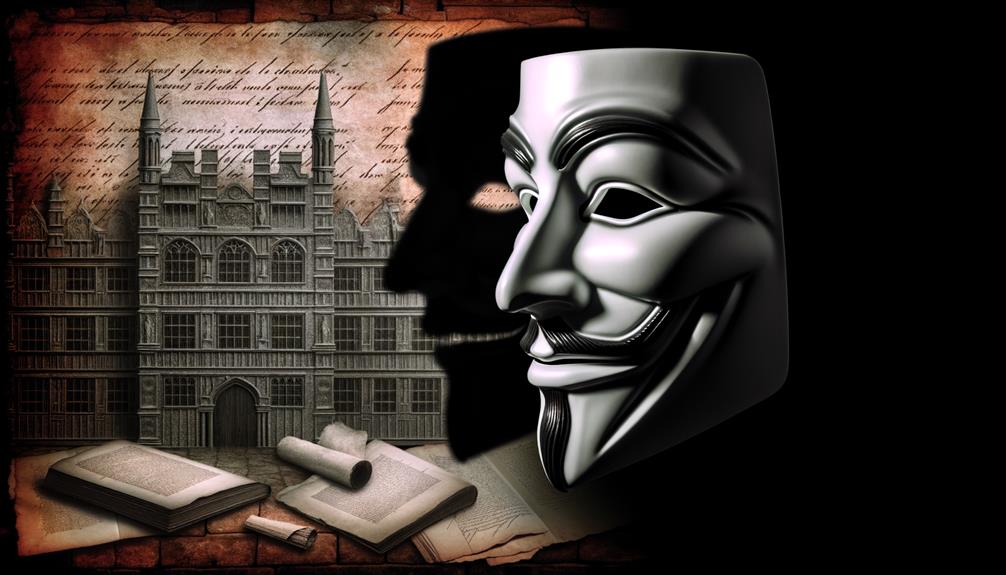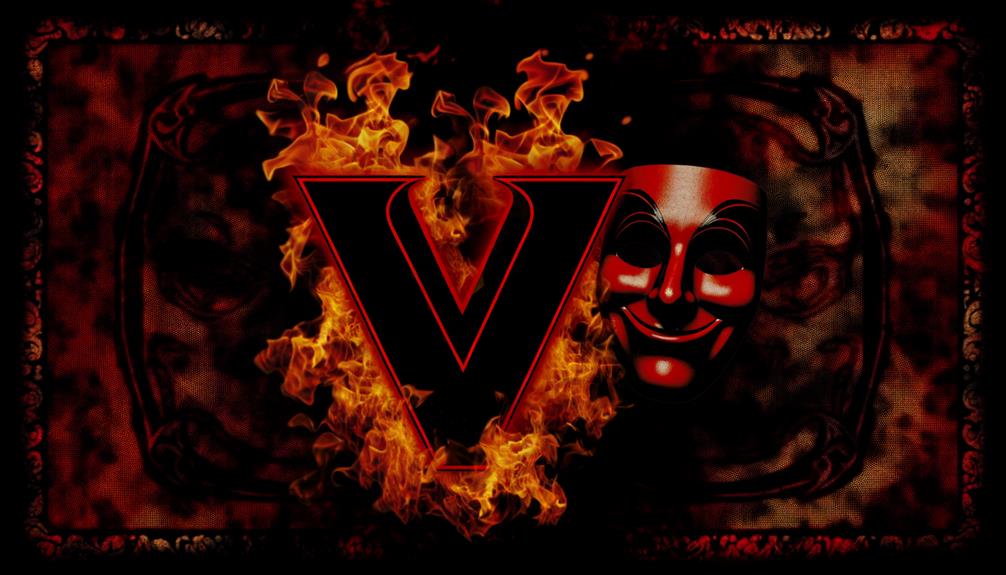What Is the Meaning of the V Vendetta Symbol?
The 'V for Vendetta' symbol, primarily represented through the Guy Fawkes mask, signifies a nexus of historical rebellion and contemporary political dissent. Originating from the Gunpowder Plot of 1605, the mask became an emblem of defiance.
Alan Moore's graphic novel utilizes this icon to critique authoritarianism and societal erosion. The subsequent film adaptation amplified its recognition, aligning the mask with global movements advocating for systemic change and individual freedoms.
The symbol's evolution illustrates its transformative capacity in resisting oppression and promoting justice. Exploring further will reveal its profound impact on modern cultural and ideological landscapes.

Key Takeaways
- The Guy Fawkes mask symbolizes dissent, rebellion, and resistance against authoritarian regimes.
- V's Labyrinth represents the complexity of fighting for freedom and challenging oppressive systems.
- Fireworks in the story symbolize hope, revolution, and the power of the collective voice.
- Roses are a symbol of V's personal vendetta and the beauty intertwined with his fight for justice.
- Surveillance themes critique the erosion of freedoms and the omnipresence of authoritarian control.
Origin of the Guy Fawkes Mask

The Guy Fawkes mask, which has become an emblem of resistance and anonymity, traces its origins to the historical events of the Gunpowder Plot of 1605. This conspiracy, orchestrated by a group of English Catholics, aimed to assassinate King James I and restore a Catholic monarch to the throne.
Guy Fawkes, one of the conspirators, was apprehended while guarding explosives beneath the House of Lords. His subsequent capture and execution transformed him into a symbol of dissent against governmental oppression.
Over centuries, Fawkes' visage evolved from a figure of treason to an icon representing both rebellion and the quest for justice, encapsulating complex socio-political narratives that resonate with contemporary movements advocating freedom and defiance against autocratic rule.
Alan Moore's Vision
Alan Moore's vision for 'V for Vendetta' intertwines dystopian themes with political commentary, creating a narrative that challenges societal norms and authoritarianism.
Moore's work is deeply embedded in the socio-political landscape of the 1980s, reflecting anxieties about state surveillance, loss of individual freedoms, and the perils of totalitarian regimes.
By crafting a world where the government exerts oppressive control over its citizens, Moore invites readers to question the boundaries between order and chaos, freedom and tyranny.
His narrative strategy employs a complex protagonist whose actions and ideology provoke critical reflection on the nature of resistance and rebellion.
Ultimately, Moore's vision is a theoretical exploration of power dynamics, emphasizing the importance of vigilance and dissent in preserving democratic values.
Symbolism in the Comic

How does symbolism in 'V for Vendetta' function as a vehicle for conveying deeper political and social critiques within the narrative? Alan Moore masterfully employs symbols to critique totalitarianism, social conformity, and the power of individual resistance. The Guy Fawkes mask, for instance, transcends its historical context to represent rebellion against oppressive regimes.
| Symbol | Representation | Analysis |
|---|---|---|
| Guy Fawkes Mask | Rebellion | Symbolizes the fight against tyranny and the power of anonymity. |
| V's Labyrinth | Complexity of Freedom | Reflects the intricate struggle for liberty and individual thought. |
| Fireworks | Revolutionary Change | Represents the explosive nature of revolutionary actions. |
| Roses | Memory and Resistance | Symbolize personal loss and the enduring spirit of resistance. |
| Surveillance | Oppression | Highlights the pervasive control and loss of privacy in authoritarianism. |
These symbols collectively articulate the narrative's critique of societal and political structures.
Film Adaptation Impact
Building upon the intricate symbolism in the comic, the film adaptation of 'V for Vendetta' amplifies these themes while introducing new visual and narrative elements that reshape the story's political and social critiques.
The film emphasizes a more contemporary context, reflecting post-9/11 anxieties and the erosion of civil liberties. The iconic Guy Fawkes mask serves not only as a symbol of rebellion but also as a universal emblem against tyranny, thereby broadening its appeal and relevance.
Cinematographic choices, such as the stark contrast between the oppressive regime and the vibrant resistance, enhance the narrative's emotional intensity.
Consequently, the film adaptation recontextualizes the original symbolism, making it accessible to a wider audience and fostering a new generation of dissent and dialogue.
Historical Context

Rooted in the socio-political turbulence of the 1980s, the original 'V for Vendetta' comic by Alan Moore and David Lloyd emerged as a poignant critique of authoritarianism and the erosion of individual freedoms.
The narrative was shaped by the Thatcher-era policies in the United Kingdom, marked by stringent government control and socio-economic disparity.
The comic reflects anxieties about the rise of state surveillance and the suppression of dissent, themes drawn from historical instances of totalitarian regimes.
Moore and Lloyd's work serves as a theoretical exploration of resistance against oppressive systems, employing dystopian elements to underscore the fragility of democracy.
Consequently, 'V for Vendetta' situates itself as both a product and a critique of its historical moment.
The Mask and Anonymity
The socio-political critique embedded in 'V for Vendetta' is epitomized by the iconic Guy Fawkes mask, which serves as a powerful symbol of anonymity and collective resistance against oppressive forces. The mask obscures individual identities, allowing participants to unite under a shared cause without fear of retribution. This anonymity fosters a sense of solidarity and egalitarianism, essential for challenging authoritarian regimes.
| Aspect | Significance | Impact |
|---|---|---|
| Anonymity | Protects personal identity | Reduces individual risk in protests |
| Symbolism | Represents solidarity | Encourages group action |
| Iconography | Historical origins | Connects past and present resistance |
| Egalitarianism | Undermines social hierarchy | Promotes equality among participants |
| Defiance | Opposes oppression | Inspires resistance against control |
The mask serves as both a shield and a standard, embodying the universal struggle for freedom.
Modern Protests

Modern protests have increasingly adopted the Guy Fawkes mask from 'V for Vendetta' as a symbol of defiance and unity against various forms of socio-political oppression. The mask transcends its fictional origin, embodying a powerful iconography of resistance.
Theoretical frameworks suggest that its widespread use taps into collective consciousness, providing a shared visual lexicon that unites disparate movements. Contextually, the mask acts as both a literal and metaphorical shield, concealing identities while symbolizing anonymity's protective power.
This dual function allows activists to articulate dissent without fear of retribution, aligning with broader trends in digital and street-level activism. Consequently, the mask has become a salient emblem within the semiotics of contemporary protest culture, reflecting deep-seated discontent and the quest for systemic change.
Global Adoption
Significantly, the Guy Fawkes mask's global adoption highlights its evolution from a niche symbol to a ubiquitous emblem of resistance across diverse socio-political landscapes. This transformation is underpinned by its widespread use in various movements and protests worldwide.
The mask's appeal lies in its versatility and symbolic potency, representing defiance against perceived oppression and injustice.
- Occupy Wall Street: A rallying image for economic inequality protests.
- Anonymous: An emblem of digital activism and hacktivism.
- Arab Spring: A symbol of revolutionary fervor and democratic aspirations.
- Hong Kong Protests: A marker of resistance against authoritarian governance.
- Global Climate Strikes: An icon for environmental activism.
These instances underscore the mask's capacity to transcend cultural and geographical boundaries, becoming a universal signifier of dissent.
Cultural Significance

Emerging from the pages of Alan Moore's graphic novel, the Guy Fawkes mask has evolved into a potent cultural artifact, symbolizing resistance and subversion within contemporary socio-political contexts. Its imagery transcends its historical origins, becoming a universal emblem for movements challenging authoritarianism and systemic inequities.
The mask's anonymity underscores collective identity over individual recognition, fostering a sense of unity among disparate groups. Its adoption by entities like Anonymous and global protestors underscores its resonance in digital and physical spaces. The mask's pervasive presence in demonstrations worldwide signifies a shared visual lexicon, facilitating cross-cultural solidarity.
The Guy Fawkes mask operates as both a visual shorthand for dissent and a theoretical construct for analyzing modern resistance dynamics.
Future of the Symbol
The future of the V for Vendetta symbol lies in its potential to continually adapt and resonate with evolving cultural dynamics and societal challenges.
As contemporary movements harness its imagery to advocate for various forms of resistance and change, the symbol's impact is likely to expand and diversify.
Understanding its trajectory involves analyzing how its foundational themes of rebellion and anonymity are reinterpreted by future generations.
Symbol's Cultural Evolution
As the V for Vendetta symbol continues to permeate various facets of popular culture, its evolution reflects a dynamic interplay between historical context and contemporary social movements. The symbol, rooted in Guy Fawkes' visage, now transcends its original narrative to embody a broader range of socio-political sentiments.
Its cultural journey can be seen through:
- Protest rallies, where masks symbolize resistance against perceived tyranny.
- Digital activism, featuring prominently in online campaigns.
- Artistic expressions, from street murals to high fashion.
- Film and literature, inspiring new works that explore themes of rebellion and freedom.
- Merchandising, with the mask becoming a global commodity.
This multifaceted evolution underscores the symbol's enduring relevance and its capacity to adapt to diverse ideological landscapes.
Impact on Modern Movements
In contemporary socio-political discourse, the V for Vendetta symbol serves as a powerful emblem for modern movements advocating for systemic change and individual freedoms. Its adoption by various groups underscores a collective desire for justice and transparency.
The symbol's future relevance lies in its ability to transcend specific contexts, acting as a universal call to challenge authoritarianism. The mask's anonymity enables a decentralized approach to activism, fostering inclusivity and broad participation.
However, its widespread use also risks dilution of its original intent, necessitating continuous reinterpretation. This symbol's enduring impact will hinge on its alignment with evolving socio-political paradigms, ensuring it remains a potent tool for catalyzing progressive transformation in an increasingly complex global landscape.
Conclusion
The Guy Fawkes mask, rooted in historical rebellion, juxtaposes Alan Moore's dystopian vision with modern protest movements. Its symbolism evolves from a literary artifact in 'V for Vendetta' to a global emblem of resistance, influenced by both historical context and cinematic portrayal.
This transformation underscores the dynamic interplay between cultural products and societal movements, highlighting the mask's enduring relevance. Future iterations will likely reflect shifting paradigms in political and cultural resistance, continually redefining its significance.




